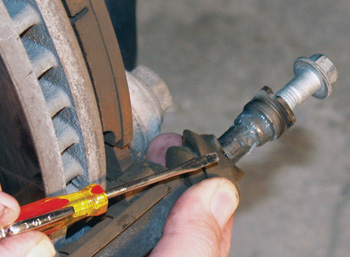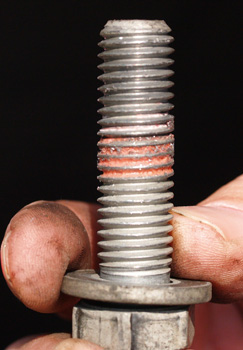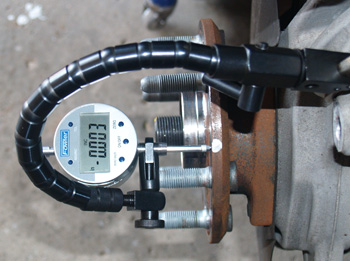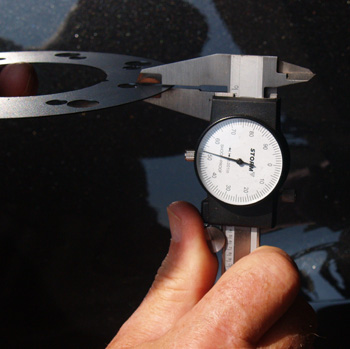led lateral runout: 0.06 mm (0.002”)
• Maximum allowable scoring: 1.50 mm (0.059”)
• Max allowable thickness variation: 0.025 mm (0.001”)
 Rotor Lateral Runout Inspection Procedure
Rotor Lateral Runout Inspection Procedure
The hub and rotor are matched with the rotor indexed to the hub and secured with a Torx setscrew. Three lugs should be used to ensure the rotor is secured to the hub. Attach the dial indicator to the steering knuckle and position the indicator at 90º to the rotor surface approximately 12.7 mm (0.50”) from the rotor. Replace any rotor that is worn or machined below this specification.
If the rotor is within runout specification, new pads and anti-rattle clips can be installed. If the rotor is out of  specification for lateral runout, a shim between the hub and rotor can correct the runout.
specification for lateral runout, a shim between the hub and rotor can correct the runout.
Shim Installation Procedure
GM has approved the shims from Brake Align for the correction of the runout for rotors machined on both on- and off-vehicle lathes. Mark the high spot on the rotor and the stud closest to the high spot. To check the bearing hub, remove the caliper bracket and rotor.
Remove the caliper bracket. It is secured to the knuckle with 19 mm bolts with thread lock adhesive. When replacing the bracket, clean the bolt and apply thread lock adhesive to the center section of the threads. Torque the front caliper bracket mounting bolts to 175 Nm (129 ft/lbs). The torque the rear to caliper bracket mounting bolts to 200 Nm (148 ft/lbs). Remove the Torx retaining screw and rotor. The hub is checked at the outer machined surface with the indicator at 90º to the rotor’s surface.
Mark the hub for run out and the stud closest to the high spot. The machined surfaces of the hub and rotor should be cleaned before the shim is installed with the V-notch aligned with “high spot” on the vehicle hub. Reinstall the rotor and torque the retaining screw to 12 Nm (106 in/lbs).
with “high spot” on the vehicle hub. Reinstall the rotor and torque the retaining screw to 12 Nm (106 in/lbs).
Parking Brake
The parking brake is located in the hat section of the rear rotor. It is applied mechanically by a cable actuated cam and lever located in the bottom of the backing plate. The shoes are attached to the backing plate with a pin and leaf spring. The shoes are held against the cam and lever with a spring.
A spring is also used to hold the shoes against the adjusting screw. The shoes are adjusted by rotating the star wheel on an  adjusting screw located at the top of the backing plate. There is an adjusting slot located in the hat section of the rotor. It will require an old fashioned adjusting spoon to reach the star wheel.
adjusting screw located at the top of the backing plate. There is an adjusting slot located in the hat section of the rotor. It will require an old fashioned adjusting spoon to reach the star wheel.
The method of adjustment is to turn the rotor and adjust the star wheel until the shoes drag on the drum. Then back off the adjusting star until the rotor turns free. The rotor should be secured with the retaining screw and three lug nuts when the parking brake shoes are adjusted.
Bleeding
Like most modern brake systems with ABS, the system has an automated bleed procedure that requires a scan tool. An automated bleed is required if a hydraulic component like the modulator unit is replaced. Even if you are performing a gravity, pressure or manual bleed, it is a good idea to run an automated bleed procedure as a way to ensure the there is not any air trapped in the brake modulator or proportioning valve assembly.
The bleeding sequence is left front, left rear, right front and right rear. If pressure bleeding, GM recommends between 25-30 psi.
Service Hints
What if the booster does not feel right?
If the brake booster activates excessively or if excessive effort of the brake pedal is consistently required, Hydraulic Brake Booster “HBB” calibration may be needed. To do this, it will require a scan tool with the right software. The procedure is simple and requires pressing the brake and gas in the right sequence.
What if the brake pedal squeaks on application?
TSB 08-05-22-002B is one of the most curious on record for a manufacturer. The bulletin covers all of the the Acadia and a lot of GM vehicles from 2004-2008.
The bulletin states: Some customers may comment on a squeak noise when the brake pedal is applied or when released. This noise is normally heard when the brake pedal is slowly applied with the engine on or off, but can occur when the brake pedal is released.
The noise may be isolated to the master cylinder area.
To correct the problem, GM advises removing as much of the old brake fluid from the master cylinder as possible and refill with new DOT 3 brake fluid. Start the vehicle and fully cycle the brake pedal until the noise diminishes to allow the new fluid to enter the system. Was it a bad batch of brake fluid? GM has been silent on the cause.
What if the customer complains of ABS noise during first driving? (Enclave, Acadia and Outlook 2007 & 2008 Model Years)
Some customers may comment on excessive ABS initialization noise, which may be mistaken as front suspension noise. In addition, customers of 2008 model year vehicles may comment on traction control sensitivity. The ABS unit runs diagnostic routines as soon as the vehicle reaches 15 km/h (9 mph). Some customers may find the valve noise objectionable.
The cure is to re-flash the module so the self-test is less noticeable. Prior to programming, you will need to know the tire size. Calibrations for 2008 model year vehicles contain additional software to reduce the traction control sensitivity.









